 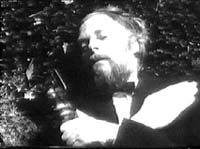 
|
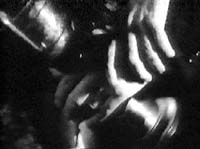 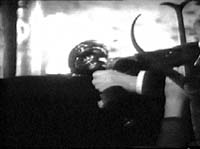 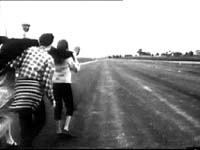
|
Cat's Cradle: from screenplay to film [1]
When Liz Hughes began filming Cat's Cradle - with R.I.P [Rest in Peace] as its working title at the time - she made a number of changes with respect to the original script, most of them involving the elimination of superfluous events.
In the script, for example, immediately after the family is presented, with the mother and three children seated around the table on which the corpse is laid out, two brief episodes explain the family's predicament. First, an old 1940's television set is carried down a dimly lit staircase by two shabbily dressed men - apparently indicating the sale of a nearly worthless family possession in a desperate attempt to raise money. In the next scene, the mother is shown counting her money in piles, examining a coffin brochure, then finally crumpling up the brochure and putting the money in a box.
Both of these scenes were eliminated because the décor, costumes, make-up and props in neighboring scenes all made it abundantly clear that this was a family that could not afford to pay for funeral arrangements. In letting the art direction implicitly communicate that predicament, Liz Hughes preferred to suggest rather than spell out the reason for the family's own initiatives to dispose of the body. In this way, the viewer is given an opportunity to work out for him- or herself the causal links at the heart of the story.
Other episodes were also eliminated. In the film, for example, there are two attempts to get rid of the body, before the family brings it to the movie theater: the first by burial, the second by cremation. In the script, a third attempt is also made: placing the corpse in a creek, after which the water drains out, leaving the body on the bottom. In this way, the elements of earth, fire and water were to be in play. The scene in the creek, however, was deliberately left by Liz Hughes until the last day of shooting, at which time she decided not to film it because she knew by then that it wasn't needed, and didn't want to subject the long-suffering actor playing the corpse to an unnecessary immersion in water. Two failed attempts - by earth and fire - were sufficient to establish the pattern.
Other things were cut from the script, not because they were superfluous but because the director felt they were out of place and would have interfered with her attempt to shape our experience in a particular manner, especially with respect to the dead father. In the script, blowflies were attracted by the corpse - their interminable buzzing heard in two scenes. Had the blowflies been included in the film, they would have suggested that the corpse was rotting, and instead of feeling sympathy for the dead father, as Liz Hughes intended, we would have felt some degree of revulsion. It was undoubtedly for the same reason that she also kept out of the film any suggestion that the body exuded an odour of death. This, too, meant a departure from the script in which the mother - having dressed her dead husband - "catches a whiff of him and moves away for a moment."
Liz Hughes also made several important additions to the script.
There is, for example, no mention in the screenplay of a tin mug in the hand of the corpse, when the dead father is first seen stretched out on the kitchen table. Nor is there any mention of the trophy the mother places in her dead husband's hand, in place of the mug, once she has dressed him in his Sunday best.
  
|
  
|
In answer to my questions about the mug and trophy, Liz Hughes replied:
In a pre-production design meeting we were searching for ways of giving the corpse a character in the design, costume and his belongings. I think it was Sarah Watt or maybe Anny Mokotow who came up with the idea of a drinking mug that he may have drunk his last beer out of and also the trophy - I think. These objects were suggestions that felt right in the overall texture of the film as well as a way of hinting his character. Also these objects felt right in some way to do with my own life experience.The removal of the blowflies and odour, and the addition of the mug and trophy, all contribute to making the dead father a person in our eyes rather than a thing. Even though the trophy has been placed in his hand, and his fingers made a slight crunching sound as they were closed around its handle, he appears nevertheless to be holding the trophy, to be unwilling to let go of this object which suggests that he has a story of his own. And despite his being dead, he comes across as a man on a journey, carrying with him, for all to see it, an emblem of some former triumph. At the same time, of course, the sight of him holding the trophy which bobs along as he is carried aloft, is also unspeakably funny.The drinking mug became a tin mug because it was more in keeping with the atmosphere of the house and because it felt more like his precious object. Also a lot of my childhood has seeped through to the film. Some of which was spent in working class England where drinking plays an important and comforting role in the lives of my relatives. I can't quite put into words the connection but I'm sure there is one.
I thought of the trophy as something that he may have won when he was a kid or something. Something that he'd had for a while and that was a part of him. It felt right for him to carry his precious object with him much like when people are buried with all their treasures. Like in Egypt, or even Thailand. It also probably felt particularly right because just before I made the film, I'd been helping my dad and his friend document the design of patterns on burial pots that had been dug up from graves in northern Thailand by Villagers. My dad believed that these patterns proved that Thai civilisation was actually older than Chinese and he was trying to document the patterns before all these pots disappeared out of the country to foreign collectors.
All of these changes strengthen his connection to the world of the living, and in the final scene, enable us to be tickled - rather than made uncomfortable - by the cosy development in the movie theater. In other words, an essential part of the set-up leading to the pay-off in the movie theater - that is, to the punch line of the film's macabre joke - consists in preparing us to accept as a delightfully funny surprise, what might otherwise have come across as tacky; and the changes made with respect to the dead father, can therefore be seen as necessary adjustments in the elaborate set-up of the film.
Another important addition is the Cat's Cradle game of which no mention is made in the original script, though Liz Hughes conceived the image of the daughter playing that game at about the time the script was written, or very soon after that. The idea for it was triggered by a discussion she had with Melissa Juhanson, her classmate at the Swinburne Film School, and co-editor of Cat's Cradle.
The prominent role played by the child's game at the start of the film is unmistakable. In the very first shot, the daughter occupies a central position, seated along with the rest of her family at the table on which her dead father is laid out. Already in that shot, though seen from a distance, she is playing cat's cradle. The third shot in the film is devoted entirely to her and her game, seen frontally and almost in close-up, and in the fourth shot, the father's face is actually filmed through the string looped across the daughter's fingers.
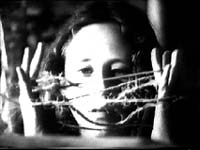 Shot 3 |
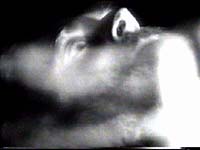 Shot 4 |
As already mentioned, the working title for the film was R.I.P, a title Liz Hughes didn't like from the beginning, but kept for the time being until a better one turned up. Her friend, Lisa Herbert - who had come up with the title for an earlier film, Jam (also made in 1991) - offered to come up with one for the present film. In reply to my questions about the title, Liz Hughes provided the following information:
[Lisa Herbert] found about 50 titles all of which didn't feel right. Then Juli Balla, a very good friend came to Melbourne to do a fashion shoot and came and had a look at the cut. She said to me in passing "what's the game the little girl is playing?" I told her Cat's Cradle and she said that's what you should call your film. I was so sick of titles by this stage that they all sounded boring. She could see how bored I was with the notion of the title and just said something like... Look it's Cat's Cradle - trust me. Juli knows me and the way I see the world extremely well and never insists on anything unless she's convinced it's appropriate. Then I said the title over in my head a few times and thought yep it's great - she's right.One of the things that makes Cat's Cradle a more suitable title that R.I.P is the fact that its connection to the story is both direct - in that it is anchored in three of the film's first four shots - and also oblique, since the relationship between the child's game and the story as a whole is something of a puzzle. In fact, the film can be seen as itself a puzzle, as one of our film students, Lotte Pape Damgaard, eloquently wrote in a recent term paper:The reason that the credits thank Lisa for the title is because they were all shot before the final title was decided on. Juli was also thanked in the credits and wasn't too worried that I'd thanked the wrong person for the actual title. She didn't want to see me spending more money reshooting the credits.
The Cat's Cradle title refers to a child's game, in which a finger web is made with a string. You solve one puzzle [or riddle] only to make a new one which is sent on to another person. In a similar way, the viewer is caught in the film's "web", in its puzzling universe, from which it is impossible to pull free.[2]In another perspective as well, the child's game sums up basic aspects of the film, since even the family's need to dispose of the body can be seen as a kind of puzzle to be solved by trial and error, and involving a succession of moves which either fail or succeed.
With respect to the successful outcome of that game in the movie theater, seen in relation to the overall meaning of the film, David Cox took a particularly bold stand in Filmnews (February 1992), when he wrote:
The "story" (such a strong point with Swinburne films) can be summarised thus: a dead or catatonic man is carried by two women from place to place. The ground is too hard to dig, the furnace of the crematorium too small, but the confines of a cinema auditorium are just fine. Dark, dead and passive; a sharp commentary on the notion of the passivity of the role of "the audience". The dead figure in the last frame stares from his cinema seat back directly at us leaving us in no doubt as to Liz's point. There is nothing more dead than an audience. Cinema is dead.I thoroughly disagree, though I admire David Cox's courage in sticking his neck out that far. My own view is that the cinema is depicted positively in this film, as a locus of problem-solving.
In a 3-minute film Liz Hughes co-directed with Nick Heydon in 1990, called Simon of the Seaweed, a man who is apparently dead is lying
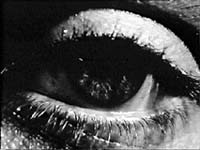
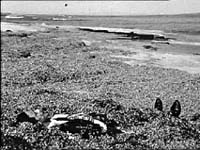 From Simon of the Seaweed, co-directed by Liz Hughes and Nick Heydon in 1990. |
on a beach, his eyes wide open. Gradually, the wind blows seaweed over him, to the point where he is completely covered by a blanket of seaweed. The next to last shot shows the sky, apparently seen from the dead man's point-of-view. Then the final shot, an extreme close-up of an open eye, startles us by ending with the eye blinking. As I see this film, which has obvious parallels to "Cat's Cradle", it is as though the sky - working through the open eyes and perhaps with the help of the blanket of seaweed - calls the dead man back to life.
Cat's Cradle ends with a frontal two-shot of the dead father and his newly found girlfriend, both of them looking intently at the screen. An observant viewer cannot help but notice what seems to be a tear glistening in the dead man's left eye. Liz Hughes informed me that this was not intentional; the actor was tired at the time, and his eye began to water during the take. However, the director was fully aware that the glistening tear was visible, and deliberately chose to use this take, though others were available, leaving it up to the viewer to draw his or her own conclusion.
My own view is that the cinema is portrayed in Cat's Cradle as the place where even impossible problems can be solved and where the magic working through our eyes and ears is so potent that anything can happen. Here, cinema is about casting a spell, with stark and unforgettable black-and-white images on TriX film stock, and a haunting sound track unlike any I have heard before and that continues to startle even after repeated viewings of the film.
1 I am grateful to Liz Hughes for sending me a copy of her script and for answering a number of questions, via fax and telephone, in January 1996. The script is not reproduced here, in accordance with her wish that it not be published at this time.